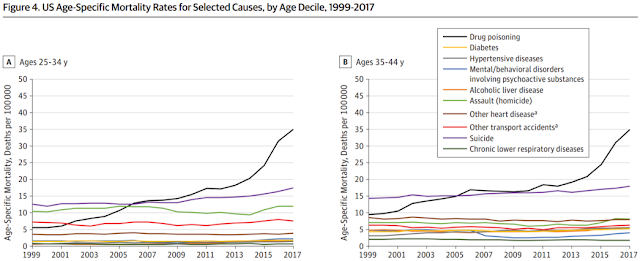Substance abuse drives decrease in life expectancy in U.S., Ky.

By Al Cross
Kentucky Health News
Americans are dying younger, and Kentucky is a big part of that.
The most basic measurement of a population’s health, life expectancy at birth, has decreased in the United States for three straight years, and in Kentucky for four. The leading cause is drug overdoses, but there are many other factors.
In 2000, Kentucky had a mortality rate of 425 deaths per 100,000 people; in 2017, the rate was 512 per 100,000, an increase of 20 percent. Most of that increase, 14.7 percentage points, occurred from 2010 to 2017, according to a study published in the Journal of the American Medical Association.
Eight states had greater increases: New Hampshire, 23.3%; West Virginia, 23%; Ohio, 21.6% Maine, 20.7%; Vermont, 19.9%; New Mexico, 17.5%; South Dakota, 15.5%; and Indiana, 14.8%.
 |
| For a larger version of any image, click on it. |
The study calculated the “excess deaths” caused in 2010-17 by the increase in midlife mortality, defined as deaths of people aged 25 to 64. It said there were 1,524 excess deaths in Kentucky, 1,839 in Indiana, 3,179 in Pennsylvania (where the mortality rate rose 14.4%) and 4,730 in Ohio. The study report said higher midlife mortality in 2010-17 “was associated with an estimated 33,307 excess U.S. deaths, 32.8% of which occurred in four Ohio Valley states.”
The report said, “The increase in opioid-related deaths is only part of a more complicated phenomenon and does not fully explain the increase in midlife mortality rates from other causes, such as alcoholic liver disease or suicides (85.2% of which involve firearms or other non-poisoning methods.) . . . Two recent studies estimated that drug overdoses accounted for 15% or less of the gap in life expectancy between the United States and other high-income countries in 2013 and 2014, respectively.”
 |
| Dr. Steven H. Woolf |
The study was done by Dr. Steven Woolf of Virginia Commonwealth University in Richmond and Dr. Heidi Schoomaker of Eastern Virginia Medical School in Norfolk.
“We found increases in 35 causes of death,” Woolf told MedicalResearch.com. “An increase in mortality spanning 35 causes of death is difficult to blame on a single cause, such as the opioid epidemic or obesity. The pervasive trend suggests a systemic cause, something distinct that is causing this to occur in the United States and not other wealthy nations. . . . Job losses in manufacturing and other sectors, stagnant incomes, and widening income inequality could contribute to poor health in multiple ways and would explain the disproportionate impact we observed in the Rust Belt and other areas hit hard by the economy. This suggests that, while it is important to treat the ‘symptoms’ of this trend (addressing drug abuse, the obesity epidemic, etc.), social and economic policies to improve education, create good jobs, and invest in communities may be even more important in reversing this trend. If we fail to act, the trend is likely to continue, and that will mean that our children will live shorter lives than ours.”